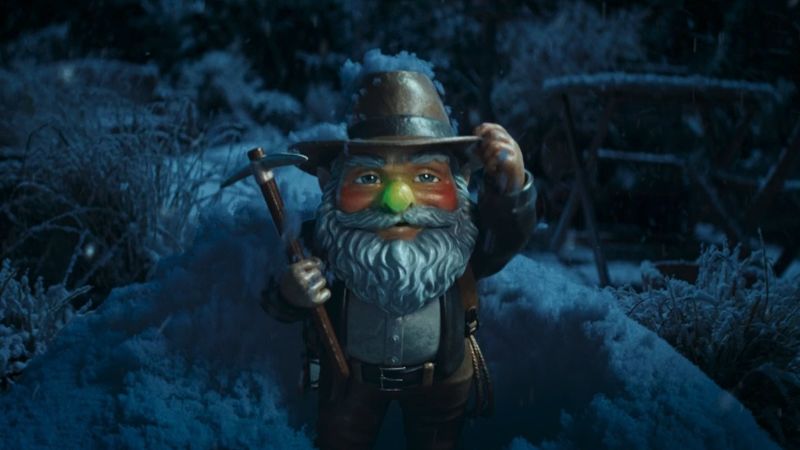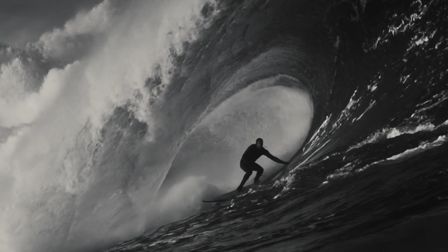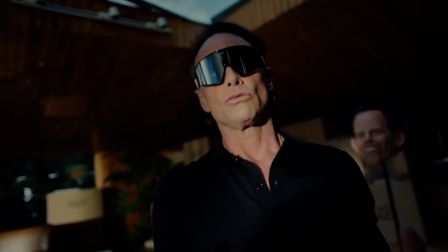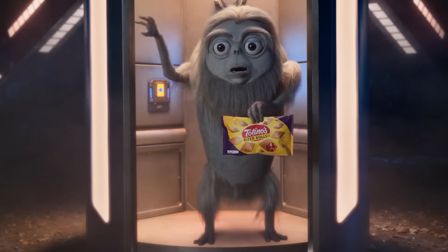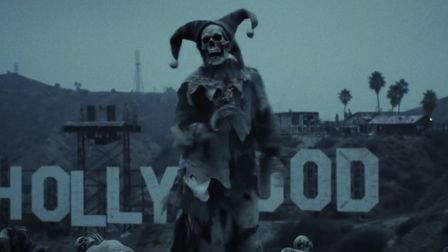Behind the Scenes on Usain Bolt's Virgin Campaign
BBH's Davud Karbassioun on working with Usain Bolt for Virgin Media's new campaign, a series of ten 9.58sec films.
Credits
powered by
Unlock full credits and more with a Source + shots membership.
Credits
powered by
- Agency Bartle Bogle Hegarty (BBH) UK/UK
- Head of Production Davud Karbassioun

Credits
powered by
- Agency Bartle Bogle Hegarty (BBH) UK/UK
- Head of Production Davud Karbassioun
This Wednesday [July 6] Virgin Media aired a 100 second spot featuring 100m world record holder Usain Bolt called 9.58 [above].
A celebration of the Jamaican athlete's life and his dedication to his sport, the film, which is a series of 10 mini-films each of which is 9.58 seconds (the time of Bolt's 100m world record sprint), is epic in concept and complexity.
Here, BBH London's managing partner and head of film, Davud Karbassioun [below left, with Bolt], who acted as producer and creative on the project, explains the thinking behind the idea, how it all came together and what it's like working with "one of the greatest sportsmen of all time".

Tell us about the concept behind the campaign and how you arrived at it?
We started with the thought of using Usain Bolt’s 100m world record time of 9.58 seconds as both the theme and the format for a film. We wanted to create a film about the man who has dominated the most democratic and accessible sporting event in the world, the 100m sprint.
There is something special about the 100m Olympic final. It’s a rare moment where the whole world stops in silence, holds their breath and then, when the starter pistol fires, shouts like mad for 10 seconds.
We decided to create a 100 sec film built up of a sequence of 10 precise 9.58 second mini-films, each offering a different perspective on what it takes and what it feels like to #BeTheFastest.
Rather than play to the caricature of Bolt, we wanted to focus on what makes the big man tick. We wanted to show different perspectives of the legend and give him the respect he deserves as he prepares to write the final chapter in his incredible legacy.

This is a departure from Virgin’s previous campaigns with Usain Bolt; what made you decide to go in a different direction?
Fast speed broadband is Virgin Media’s edge in technology, which is how the brand came to be associated with Bolt. It’s been a successful and longstanding relationship, so we felt like we had a unique opportunity to properly salute Bolt’s story as he prepares to run the last Olympic 100m race of his career.
Our client, [Virgin Media CMO] Kerris Bright, challenged us to write “the ultimate Bolt film”. As a result, this film had to go deeper into his story than ever before. It couldn’t be another athletics spot with beautiful cinematography and inspiring, poetic prose – it had to have its own filmic voice if it was going to disrupt in the cluttered run-up to Rio.
An example of a previous Bolt-starring Virgin Media spot.
Because Bolt is still competing, I don’t think the world has reflected on his career the way we have with past legends. He holds three world records (100m/200m/4x100m relay), has won the triple gold in the last two Olympics, won triple gold in the last four World Championships (aside from one race when he famously false-started). On top of that he is universally adored.
The moment the starter pistol fires on the 14th August [for the men's 100m final] I don’t think there are many people on the planet that won’t be cheering him on. He makes people smile. He gives hope to a sport tarnished by drug cheats. He truly is one of the greatest sportsmen of all time. Usain himself would argue that that title belongs to the late, great Mohammad Ali. But if anyone even comes close, it’s Bolt.
How did Virgin, and indeed Bolt, initially take to the change of direction for the campaign?
They were as ambitious as we were to make something special. They loved and supported the idea from the moment we presented it. Our clients are fantastic, they went out of their way to help push the idea and we were always 100 per cent aligned on the big ambition.
They have a close relationship with Bolt and his team, so we leveraged that to get closer to him and get insight and a performance from him that I don’t believe could have been unlocked with or for any other brand.

The campaign is a reflection of Bolt’s life both inside and outside of athletics; how did you decide which elements to focus on?
We did a lot of research. Seb [Edwards, director], Nick [Gill, ECD] and I became a bit Bolt-obsessive. We watched every documentary, read his autobiographies over and over again, talked to people he grew up with and know him best. The deeper you dig, the more you love and respect the man.
We had so many ideas; too many - we covered so much, and spent long meetings at BBH and Academy with a collage of ideas on the wall. Everything in the film had to be about what it takes and what it feels like to #BeTheFastest.
Every idea comes from a truth, even the finest detail. For example, as a child Bolt was obsessed with arcade games. He used to skip training and hide at the arcade. That’s why we see a young Bolt racing imaginary arcade characters on his run home from school.
On location with Bolt in Jamaica.
Was Bolt involved in deciding what should be portrayed in the film?
We shared concepts with him and his right hand man, NJ, early on. They loved the ambition and helped us with some insight and how best to represent Bolt authentically. I think he could tell we wanted to make the ultimate Bolt film. A film he would proud of.
He went out of his way to help push things. That said, he was preparing for the Olympics so there were limitations. He said he could only run at 20 per cent speed (he ran at 50 per cent, which, trust me, is still crazy fast!). He stretched intensively before and after the physical set-ups and we didn’t have a lot of takes on the big action shots.
Given the longstanding relationship with Virgin Media, I think he trusted us to respect and represent the Bolt brand. I’ve heard he loves the film, we had a lot of fun making it and hopefully is as proud of it as we are.

The plan for the structure of the 10 x 9.58 second films.
You acted in a more creative role on this campaign than you might normally; how was that experience?
I think all the best producers have a creative opportunity and responsibility in helping shape the work. Nowadays, more than ever, we need to be proactive to help unlock ideas and get them over the line. What we make and how we make things is more important now than ever before.
In this case I was interested in the format of the film and using 9.58 seconds to do something interesting, something disruptive that didn’t have the classic structure you’d expect for a traditional commercial. I am lucky as I work so closely with the master, Nick Gill, and have done for such a long time. We’ve made a few films together that play with the language of film so we both loved the challenge set by the format.
He’s very generous and collaborative in his creative process and in creative ownership. That’s his style and that’s why I (and I think a lot of directors) love working with him. He’s over-generously crediting me publically for my creative input, but I’m not a creative, I’m a producer and always will be.
Why was Seb Edwards the best choice to direct the film?
Seb is one of the best directors I’ve had the pleasure of working with. He has an incredible aesthetic to his work. It’s beautiful but it has unique authenticity to it. He also has the ability to get very real performances from real people. Watch his Princes Trust film [below]! I knew what he is capable of so he was top of the list early on.
It was so important we got a fresh perspective on the real Bolt and that we found different lenses to do that through. Seb not only unlocked that on the day, but brought so many great ideas to the table. He’s obsessive about the detail and uncompromising with it. I love directors that are stubborn, but back up every detail with perfect rational.
Not taking anything away from our director (and we had the best), I think it’s important to name-check the producer. Dom Thomas at Academy is a different class and had an incredible challenge delivering this complicated production. I know I’d say it because I’m a producer, but on a project like this, and on so many projects these days, the producer and production company are critical to over-delivering. Dom and Academy were a different class.
Bolt, Karbassiuon and Gill on set.
There are various styles and crafts on show in the finished film; was that approach always the plan?
We liked the idea that the film was a scrap book of Bolt’s life, the hard work, the fun, his upbringing, his fans, his beloved Jamaica. We wanted the film to be a collage of textures and perspectives. Seb is obsessive about the craft and is very versatile. He was always focussed on the bigger idea, shifting the craft to suit to purpose of each 9.58 second segment.
So, we have a mix of beautifully shot footage of Bolt on the starting blocks, real stock footage of fans watching the famous 9.58 second race, beautiful portraits, landscapes, famous footage of Bolt in competition, an animated title sequence to the Bolt Superhero cartoon, data visualisation of the actual race and even a POV reconstruction of the exact distance and speed he broke the record in locations across Jamaican that he grew up running in.

The team shot Bolt at a Dancehall in Jamaica for the film.
The film was shot in Jamaica; how long were you out there and how much access did you have to Bolt over the course of that time?
It was important we shot in Jamaica as we wanted to get to the real Bolt. Bolt could have emulated the path of many of his Jamaican contemporaries and gone to the US for a lucrative scholarship, but he stayed in Jamaica to train and live the life he loves.
We shot there for four days, but were out there for two weeks. It was an incredibly tough shoot as we had so many different set-ups to cover. There were large range of people and locations, even though each element may only feature for a couple seconds at most. As a result, we could cut a 100 second [film] on Jamaican Dancehall Culture, 100 seconds of training, 100 seconds of Bolt as a child. We have so much and are going to use that through the campaign across social media channels.
Jamaica isn’t a place that you get to shoot in often. In fact, unless you’re doing a film with Bolt you’ll probably never shoot there. As a result, I hope the film has captured everything that is beautiful about that country, the people, the spirit, the locations. The president of Jamaica has just posted the film on Facebook, which is a good sign!

The voice over from Michael Johnson gives the film an increased gravitas; was that why he was chosen for the VO?
There is a great story that the first time Bolt saw any Olympic footage it was on a VHS his coach showed him of Michael Johnson in his prime. That’s when Bolt took things seriously. He had an idol.
Usain always talks about him as his hero. Equally, Michael has huge respect for Bolt in return. He was the only voice that could be on this film and, as we’ve all discovered from his BBC punditry, he speaks nearly as well as he runs. When Michael (still the world 400 metre record holder by the way) watched the film he grinned. Then he assured us, in that wonderful voice, that Bolt, if fit, could triumph again in Rio.
In the admittedly unlikely event that Bolt breaks his own world record, will the individual spots which make up the complete film be recut from 9.58 seconds?
We have a few things up our sleeve depending on the outcome… People say it’s unlikely he’ll break that incredible record right now. People said that last time though, and the time before. If there’s anything I’ve learnt about Bolt whilst working on this project, it’s not to ever bet against him.

What was the most difficult aspect of pulling the project together?
9.58 seconds is both a short time and a long time in filmic terms. Too short for each sequence to have any complicated narrative structure. But too long for these sequences to become just textural. So each sequence had to behave like a simple but clearly defined film in itself.
We weren’t making one film, we were making 10. So that was a massive production challenge. Each film had different texture, cast, locations. The sheer scale of the project was epic. It was a marathon! Not a 100m sprit.
And the most rewarding?
Getting to shoot in Jamaica, meet some incredible people and to work with the greatest sportsman of our generation.
Connections
powered by
- Agency Bartle Bogle Hegarty (BBH) UK
- Head of Production Davud Karbassioun
Unlock this information and more with a Source membership.
)
